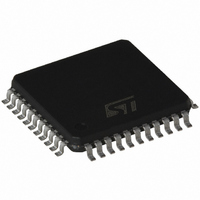ST72F324J6T6 STMicroelectronics, ST72F324J6T6 Datasheet - Page 70

ST72F324J6T6
Manufacturer Part Number
ST72F324J6T6
Description
IC MCU 8BIT 32K 44-TQFP
Manufacturer
STMicroelectronics
Series
ST7r
Specifications of ST72F324J6T6
Core Processor
ST7
Core Size
8-Bit
Speed
8MHz
Connectivity
SCI, SPI
Peripherals
LVD, POR, PWM, WDT
Number Of I /o
32
Program Memory Size
32KB (32K x 8)
Program Memory Type
FLASH
Ram Size
1K x 8
Voltage - Supply (vcc/vdd)
3.8 V ~ 5.5 V
Data Converters
A/D 12x10b
Oscillator Type
Internal
Operating Temperature
-40°C ~ 85°C
Package / Case
44-TQFP, 44-VQFP
Controller Family/series
ST7
No. Of I/o's
32
Ram Memory Size
1KB
Cpu Speed
8MHz
No. Of Timers
2
Embedded Interface Type
SCI, SPI
No. Of Pwm Channels
1
Rohs Compliant
Yes
Processor Series
ST72F3x
Core
ST7
Data Bus Width
8 bit
Data Ram Size
1024 B
Interface Type
SCI, SPI
Maximum Clock Frequency
8 MHz
Number Of Programmable I/os
32
Number Of Timers
4 bit
Operating Supply Voltage
3.8 V to 5.5 V
Maximum Operating Temperature
+ 85 C
Mounting Style
SMD/SMT
Development Tools By Supplier
ST7F521-IND/USB, ST7232X-EVAL, ST7MDT20-DVP3, ST7MDT20J-EMU3, STX-RLINK
Minimum Operating Temperature
- 40 C
On-chip Adc
10 bit
Cpu Family
ST7
Device Core Size
8b
Frequency (max)
8MHz
Total Internal Ram Size
1KB
# I/os (max)
32
Number Of Timers - General Purpose
2
Operating Supply Voltage (typ)
5V
Operating Supply Voltage (max)
5.5V
Operating Supply Voltage (min)
3.8V
Instruction Set Architecture
CISC
Operating Temp Range
-40C to 85C
Operating Temperature Classification
Industrial
Mounting
Surface Mount
Pin Count
44
Package Type
TQFP
For Use With
497-8222 - UPS (LINE INTERACTIVE - 450W)497-8436 - BOARD EVAL UPS 450W VOUT=220V497-6421 - BOARD EVAL DGTL BATT CHGR DESIGN
Lead Free Status / RoHS Status
Contains lead / RoHS non-compliant
Eeprom Size
-
Lead Free Status / Rohs Status
In Transition
Other names
497-2108
Available stocks
Company
Part Number
Manufacturer
Quantity
Price
Company:
Part Number:
ST72F324J6T6
Manufacturer:
STMicroelectronics
Quantity:
10 000
Part Number:
ST72F324J6T6
Manufacturer:
ST
Quantity:
20 000
Company:
Part Number:
ST72F324J6T6/TR
Manufacturer:
STMicroelectronics
Quantity:
10 000
ST72324Jx ST72324Kx
16-BIT TIMER (Cont’d)
10.3.3.6 Pulse Width Modulation Mode
Pulse Width Modulation (PWM) mode enables the
generation of a signal with a frequency and pulse
length determined by the value of the OC1R and
OC2R registers.
Pulse Width Modulation mode uses the complete
Output Compare 1 function plus the OC2R regis-
ter, and so this functionality can not be used when
PWM mode is activated.
In PWM mode, double buffering is implemented on
the output compare registers. Any new values writ-
ten in the OC1R and OC2R registers are taken
into account only at the end of the PWM period
(OC2) to avoid spikes on the PWM output pin
(OCMP1).
Procedure
To use pulse width modulation mode:
1. Load the OC2R register with the value corre-
2. Load the OC1R register with the value corre-
3. Select the following in the CR1 register:
4. Select the following in the CR2 register:
70/164
1
sponding to the period of the signal using the
formula in the opposite column.
sponding to the period of the pulse if (OLVL1=0
and OLVL2=1) using the formula in the oppo-
site column.
– Using the OLVL1 bit, select the level to be ap-
– Using the OLVL2 bit, select the level to be ap-
– Set OC1E bit: the OCMP1 pin is then dedicat-
– Set the PWM bit.
– Select the timer clock (CC[1:0]) (see
plied to the OCMP1 pin after a successful
comparison with the OC1R register.
plied to the OCMP1 pin after a successful
comparison with the OC2R register.
ed to the output compare 1 function.
Clock Control
Counter
= OC1R
Counter
= OC2R
When
When
Bits).
Pulse Width Modulation cycle
OCMP1 = OLVL2
OCMP1 = OLVL1
Counter is reset
ICF1 bit is set
to FFFCh
Table 16
If OLVL1=1 and OLVL2=0 the length of the posi-
tive pulse is the difference between the OC2R and
OC1R registers.
If OLVL1=OLVL2 a continuous signal will be seen
on the OCMP1 pin.
The OC
ing application can be calculated using the follow-
ing formula:
Where:
t
f
PRESC
If the timer clock is an external clock the formula is:
Where:
t
f
The Output Compare 2 event causes the counter
to be initialized to FFFCh (See
Notes:
1. After a write instruction to the OCiHR register,
2. The OCF1 and OCF2 bits cannot be set by
3. The ICF1 bit is set by hardware when the coun-
4. In PWM mode the ICAP1 pin can not be used
5. When the Pulse Width Modulation (PWM) and
6. In Flash devices, the TAOC2HR, TAOC2LR
7. In Flash devices, the ICAP2 registers
(TAIC2HR, TAIC2LR) are not available in Timer A.
The ICF2 bit is forced by hardware to 0.
CPU
EXT
the output compare function is inhibited until the
OCiLR register is also written.
hardware in PWM mode therefore the Output
Compare interrupt is inhibited.
ter reaches the OC2R value and can produce a
timer interrupt if the ICIE bit is set and the I bit is
cleared.
to perform input capture because it is discon-
nected to the timer. The ICAP2 pin can be used
to perform input capture (ICF2 can be set and
IC2R can be loaded) but the user must take
care that the counter is reset each period and
ICF1 can also generates interrupt if ICIE is set.
One Pulse Mode (OPM) bits are both set, the
PWM mode is the only active one.
registers in Timer A are “write only”. A read
operation returns an undefined value.
= Signal or pulse period (in seconds)
= CPU clock frequency (in hertz)
= Timer prescaler factor (2, 4 or 8 depend-
i
R register value required for a specific tim-
= Signal or pulse period (in seconds)
= External timer clock frequency (in hertz)
OCiR Value =
ing on CC[1:0] bits, see
OCiR =
t
*
f
EXT
PRESC
t
*
f
-5
CPU
Figure
Table
- 5
45)
16)













